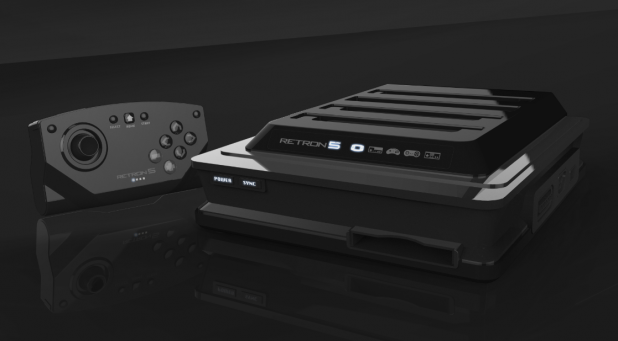If you were a kid in the late 80’s or early 90’s, you might have been forced to make a very difficult choice: Sega or Nintendo? Wouldn't it have been great to own a single system that could play games designed for any console? Nintendo and Sega would never have built a console together in the heyday of their rivalry—but now, two decades later, a company devoted to retro gaming has reverse-engineered the 20-plus-year-old hardware to create a sort of universal system. The company is Hyperkin and its product is called the RetroN. The current version is the RetroN 3, which plays NES, SNES, and Genesis games. But Hyperkin is taking the RetroN to the next level (actually two more levels) with a brand-new product called the RetroN 5. In addition to NES, SNES, and Genesis, the RetroN 5 will play cartridges from Famicom (the Japanese version of NES) and Game Boy Advance. The GBA slot is compatible with Game Boy Color and the original Game Boy, so the RetroN 5 can actually play games from seven systems. Perhaps best of all, the RetroN 5 brings HDMI capability and a host of features designed to make retro gaming feel slightly more modern. Yes, many of you already use emulators on a PC to play ROM copies of old Nintendo and Sega games. But playing ROMs of copyrighted games generally isn’t legal, even if players are unlikely to be prosecuted. You can use the RetroN with a clear conscience because it plays the original game cartridges, and you can even use the original controllers if you still have them lying around. "There’s a whole subculture of people out there going to Salvation Armies and swap meets looking for that one rare cartridge," said Lawrence Lee, Hyperkin's project manager for the RetroN 5. "We estimate there's still somewhere around 2,000 retro gaming stores in the US… When we go to small trade shows and we put out our retro stuff, we get that deer in the headlights, 'oh my god, it still exists' look. It never gets old. We love it." Lee and Hyperkin marketing director David Yu spoke with me recently via Skype to discuss their plans for the RetroN 5. While Yu was in Hyperkin's Los Angeles area headquarters, Lee was in Hong Kong handling logistics for the new console.
HDMI and Other Features
Hyperkin is scheduled to unveil the RetroN 5 at the Midwest Gaming Classic conference in Wisconsin. Besides having five cartridge slots, the RetroN 5 will have two controller ports for each system (with the NES and Famicom using the same ports, and SNES controllers powering GBA games). There will also be Bluetooth controllers designed by Hyperkin that work on any of the systems' games. Also new in the RetroN 5 is HDMI connectivity for modern TVs, in addition to AV ports that can hook up to the old "fat" screens. The RetroN 3 retails for $69.99, while Hyperkin's "SupaBoy" (a handheld SNES) goes for $79.99. Hyperkin is hoping to keep the price of RetroN 5 under $100, but a final price and release date have not yet been determined. July is the most likely release month. With the HDMI output, the RetroN 5 will be able to display games at up to 720p resolution. Hyperkin has also taken steps to eliminate the blurry effect you get when playing older, standard-definition content on high-definition screens. "When [the games] were programmed originally, there was a space in between each pixel," Lee explained. "But a modern television does not recognize that space and will attempt to fill it in with surrounding colors, which is why it's actually blurry compared to playing it on an old-school CRT [Cathode ray tube]. What we've done is we've gone back and we've put that space back into it. You can actually identify each and every pixel—it comes out looking like high definition." The boxy aspect ratio of old-school games results in black bars on the sides of a wide-screen display. Hyperkin is considering ways of filling that space, either with game data, or to stretch the picture by showing stuff that's already passed by the screen. Hyperkin is also cooking up a bunch of features gamers 25 years ago might have lusted after. Save states will be supported, just like in most emulators, with an SD card slot available to store game data. Players can overclock the games to speed things up. They can also remap the buttons on the Bluetooth controller, which has six buttons, two bumpers, and two macro keys on the side that can be used for whatever the player wishes (like loading save states, adjusting brightness, volume, game speed, etc.). Remapping of buttons on the original controllers is another feature Hyperkin is hoping to support. "What we want to do is any controller for any system," Lee said. "So if you're a Sega fanatic and you insist on the Genesis controller, but you want to play a Super Nintendo game, that should be possible. Right now it's a bit unconfirmed. We're still working on it." Another possible feature is the ability to take screenshots and record gameplay. Players will have the option to render audio at a higher output frequency, improving the sound to some ears (but perhaps taking away the classic feel). "8-bit games sound 8-bit because of technology limitations, not because they were actually supposed to sound that way," Lee said. "Users will have the option of how they want their game to sound."
Inside the RetroN 5, a Mix of New- and Old-School Technology
Lee is part of a three-man office in Hong Kong, where he says they “work full time doing sourcing, checking up on components, quality control, for the full Hyperkin line." The RetroN 5 uses an ARM-based System-on-Chip. Hyperkin prefers not to reveal the exact CPU/GPU and memory chips it uses, for fear of tipping off competitors. After all, the process of locating appropriate hardware for clone systems is a tricky one. The ARM CPU isn't anything exotic, but Lee said clones still rely on ancient memory chips. "The majority of chips for clone systems are built off of very old architecture," Lee said. "We are literally ripping out the memory from old calculators and stuff like that just to power the system right now." Being a relatively small player poses special challenges. Large chip companies "won't deal with you unless your volume is way over a quarter million," Lee said. "We have to use old chips, second-hand chips. There's a huge market for it. Its actually quite funny, if you're in the right area, there's a bunch of armed guards and there are all these chip suppliers. You see people walk up with literally a potato sack of cash to buy these chips." Just finding the right chips isn’t the only challenge—there is also the matter of getting pin connectors to fit all the different cartridge designs. "We would love to support the old systems like Atari, Sega Master System, maybe even Game Gear, but those pin connectors don't exist,” Lee said. “And to develop one, it's just not [cost-effective] at the moment. So we have to stick with these consoles, which already have pin connectors in the market. "If you can find the original part made 15 years ago, you can save yourself a huge chunk of change. So sometimes we are knocking on doors of these larger companies. Maybe you've heard of Honey Bee. They used to be a Nintendo manufacturer. You just ask them, 'Hey do you still have that thing laying around?' They look at you funny, but sometimes you actually get lucky." It's obvious why Nintendo and Sega systems use different pin connectors. Somewhat odder is that the NES uses a 72-pin system while Famicom plays the same exact games with a 60-pin system. There is an unconfirmed legend "that Nintendo thought Americans were crude, and to increase value perception they had to make the cartridges larger," Lee said. RetroN systems are hardware emulators rather than software emulators. But there are sometimes problems preventing specific games from playing, and which must be fixed on the software side. NES is the biggest source of problems. "If you plug Paperboy into some of the current clone systems, you can't press Start, because Start is configured in a different way for that one cartridge," Lee said. In another title, the B and A buttons are reversed. "Nintendo is the hardest because it was programmed so erratically," he added "Pretty much, Nintendo did not tell developers how to build the game. They just said if it works, it works and we'll give you our seal of approval if the game doesn't suck. Developers were on their own." The solution is extensive testing, with Hyperkin distributing beta systems to devoted retro gamers. "They are going to run their old cartridges, and tell us when it works and when it doesn't work," Lee said. "When it doesn't work they have been gracious enough to lend us the cartridge until we can make it work." Clone consoles typically achieve compatibility with about 97 percent of games, Lee said, noting that with the RetroN 5 his team is shooting for 100 percent. The complications of nailing down all the final details is why Hyperkin can’t announce a specific release date yet. Once the RetroN is available, there shouldn’t be any shortage—Lee suggested that Hyperkin’s supply chain will be capable of churning out 55,000 consoles a week, more than they’d expect to sell. What comes after the RetroN 5 for Hyperkin? One possibility is to emulate newer consoles like the original PlayStation from 1994 and the Nintendo 64 from 1996. Hyperkin said it can't get to those yet because Sony and Nintendo patents haven't expired, and it’s not even clear whether building them would be financially feasible. "Hyperkin’s plans for development for those upcoming consoles [the Nintendo 64 and PlayStation] are only ideas at this moment," Yu said. For now, retro gamers can bask in the knowledge that their old cartridges collecting dust in the basement can still find a home, even if that console from 1990 might no longer work. Image: Hyperkin


